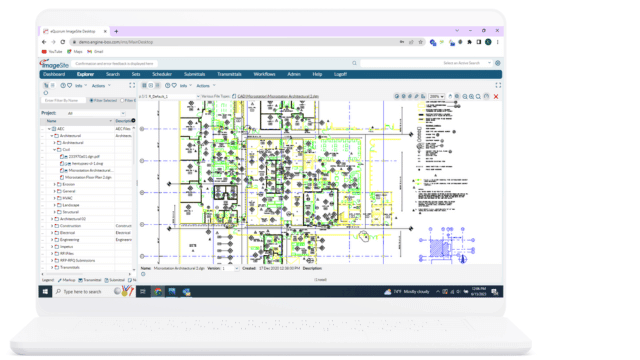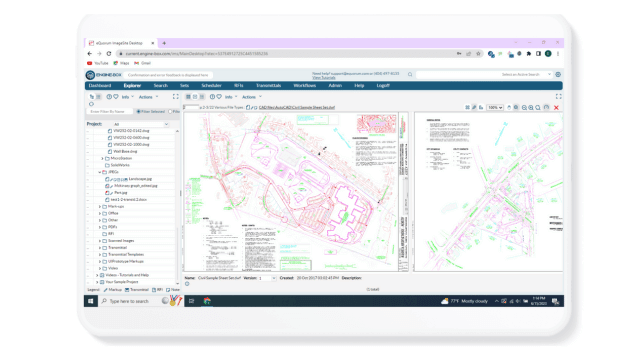eQuorum Customer Developments - What’s New NASA?
eQuorum Customer Developments - What’s New NASA?
eQuorum is proud to share with you some of our customers’ latest developments.
eQuorum partners with high-technology customers and is an intrinsic piece of the engineering control workflow. There is no doubt NASA has achieved some incredible things throughout the last century. They created the Hubble Space Telescope, explored Mars, put man on The Moon, and have essentially eliminated the word “impossible” from our vocabulary. While there are new and emerging space organizations around today, few have triggered our imagination quite like NASA. As many of us are struggling to make it though the year due to the pandemic, NASA has been making strides in innovation, and are now looking forward to new developments in space exploration.
In 2021 NASA is expected to announce which private company will be moving forward with their human landing system. Contenders include Blue Origin (funded by Amazon founder and CEO, Jeff Bezos), Dynetics, and/or SpaceX (founded by Tesla CEO, Elon Musk). Their goal is to safely send astronauts back to the Moon by 2024, and it appears as if these companies are well on their way to success.
In 2019, Bezos’s unveiled Blue Origin’s new “Blue Moon” lander, which is capable of soft-landing 3.6 metric tons on to the lunar surface. The Blue Moon lander includes equipment such as a “Star Tracker” which allows for automatous space navigation, and an optical communications system, to give astronauts and researchers gigabit bandwidth back to earth. Dissimilar to previous attempts at moon exploration, this lander is intended to utilize complete automation to explore new heights.
On the other side of the playing field, SpaceX has made major developments in its “Starship SE” (Special Edition). In a 2019 interview, CEO, Elon Musk expressed his concerns for the project saying, “…unless we improve our rate of innovation dramatically, then there is no chance of a base on the moon or a city on Mars.” Musk intends on taking his rocket beyond NASA, using the project to advance his Mars colonization efforts. He has stated he feels a fully and rapidly reusable rocket is necessary for Mars and lunar exploration, as it is a key component for making the project viable.
SpaceX's Starship-based lunar lander is very capable, NASA concluded, but also risks not being ready in time for a 2024 landing. Credit: SpaceX
While speaking at a press conference with Musk, NASA Administrator, Jim Bridenstine stated, “there is great alignment with NASA between our commercial partners,” expressing his interest in SpaceX’s newest rocket technology. With the successful simultaneous landing of SpaceX’s Falcon Heavy rocket boosters, it’s no surprise that SpaceX has garnered a ton of attention from NASA and other outside investors.
Aside from the lunar project, the NASA team also plans to begin its first planetary defense test in July of 2021, with the Double Asteroid Redirection Test (DART).
Every year, our planet is hit with objects roughly the size of a table (a pretty insignificant collision). DART, however, intends on redirecting an asteroid the size of the Washington Monument, using a car-sized projectile. Objects this size collide with earth every few thousand years, inflicting damage on a regional scale. While the asteroid in question is not a direct threat to Earth, it will be used as a test to determine whether their technology is capable of preventing a catastrophic event of this nature in the future.
Next year, NASA aeronautics teams will prepare for the initial flight of their X-59 QueSST aircraft. This aircraft is unlike any plane used by NASA in the past. It is a low-boom, supersonic X plane used to provide data that will pave the way for faster, long-distance travel. The intention behind these tests are to collect community response data on the acceptability of the quiet sonic boom generated by the unique design and shape of the aircraft, which will then be used by regulators to establish an acceptable commercial supersonic noise standard. Assuming all goes well, these tests have the potential to lift the ban on supersonic travel over land.
Learn more about our ImageSite suite of products please click here, or schedule a demo at www.equorum.com/contact-us/.
Additional EDMS Features
Our EDMS solutions
ImageSite and EngineBox are eQuorum’s robust workflow and document management solutions, created to help workers manage their essential workflows while maintaining complete control over their engineering files and documents. Not only do they provide a secure collaboration site for workers, but they also help organizations manage document distribution with third parties like vendors, contractors, and customers. Both systems are offered at a competitive price, enabling organizations to get a quick return on their investment by providing the features and functionality needed to help organizations improve efficiency, productivity, and collaboration. Companies can choose from concurrent user subscriptions or named user subscriptions, ensuring organizations have subscription options that make sense for their business.

ImageSite®
Our single source engineering workflow and document management system. Built in HTML5 so there is no software to deploy to client computers or mobile apps to download. Offered as an On-premise or Private Cloud system.
EngineBox™
EngineBox is a cloud based workflow and document management version of ImageSite that resides outside the corporate network.
Our EDMS solutions
ImageSite and EngineBox are eQuorum’s robust workflow and document management solutions, created to help workers manage their essential workflows while maintaining complete control over their engineering files and documents. Not only do they provide a secure collaboration site for workers, but they also help organizations manage document distribution with third parties like vendors, contractors, and customers. Both systems are offered at a competitive price, enabling organizations to get a quick return on their investment by providing the features and functionality needed to help organizations improve efficiency, productivity, and collaboration. Companies can choose from concurrent user subscriptions or named user subscriptions, ensuring organizations have subscription options that make sense for their business.

EngineBox™
EngineBox is a cloud based workflow and document management version of ImageSite that resides outside the corporate network.
The eQuorum Customer Promise
In 2005, eQuorum developed the first all browser-based EDMS. The system, although for on-premise use, was still created to remove client software and JAVA from user computers and allow users to have a single viewer based on the simple navigation functionality of browsers. Today, eQuorum provides that same application in a private Cloud or a SaaS Cloud option. We can do this because we are, and have always been, browser-based, understanding the enhanced speed, security, and usability of this technology.
With the abundance of document management systems on the market today, there’s no doubt that choosing the right Cloud document management software can be a difficult decision. eQuorum is here to provide a comprehensive, powerful, and most importantly – affordable Cloud document management solution. We believe in providing real value to our customers by eliminating unnecessary costs, providing industry-leading functionality, and equipping your team with the right tools using cutting edge technology to bring your products to market faster.
eQuorum®
We specialize in engineering workflow and document management. Our comprehensive, yet easy-to-use software provides the solution to manage data from design to manufacturing and production, to sales, support and administration.